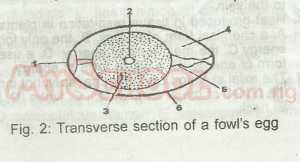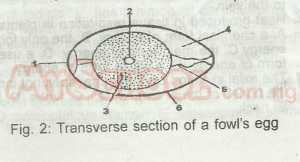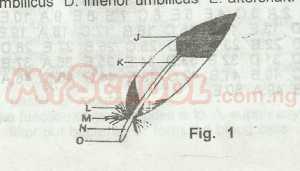
Which parts provide food for the developing chick?
- A. 2 and 3
- B. 4 and 5
- C. 3 and 4
- D. 2 and 5
- E. 1 and 2

The young chick is formed from
- A. 3
- B. 3 and 4
- C. 1, 3 and 5
- D. 2
- E. 4

The structure above represents a quill feather. The structure labelled ‘M’ is the
- A. quill
- B. rachis
- C. superior umbilicus
- D. inferior umbilicus
- E. aftershaft
The process of soil erosion is usually from
- A. rill → sheet → gully
- B. gully → rill → sheet
- C. sheet → guly → rill
- D. sheet → rill → gully
- E. rill → gully → sheet
Leaching is
- A. Washing away of humus from the soil surface
- B. reducing of soil aeration by pressure
- C. soil erosion by means other than rainfall
- D. loss of organic matter due to exposure to direct sunlight
- E. washing out chalk and limestone from upper layers of by heavy rains
Denitrifying bacteria in nature liberate gaseous nitrogen directly from
- A. ammonium salts
- B. soil nitrates
- C. thunderstorms
- D. soil nitrites
- E. plant and animal proteins
If a handful of soil is shaken with water and left to settle, the soil particles will settle from light to heavy particles as follows
- A. humus, clay, silt, sand, stones
- B. humus, silt, clay, sand, stones
- C. humus, clay,silt, stones, sand
- D. humus, sand, silt, clay, stones
- E. clay, humus, silt, sand, stones
Erosion can be reduced along shape by
- A. ridging across slope
- B. ridging up slope
- C. ridging down slope
- D. crop rotation
- E. bush fallowing system
Which of the following lists of diseases, their causes and transmission is CORRECT?
- A. Cholera, virus, severe diarrhoea, infected water
- B. Malaria, protozoan, high fever, contact with infected person
- C. Syphilis, virus, veneral disease, sexual intercourse
- D. small pox, virus, skin with blister, close contact with infected person
- E. Sleeping sickness, bacteria, tiredness, headache and dozing, tsetsefly bite
Which of the following groups of factors is completely abiotic?
- A. Salinity, tide, plankton, turbidity
- B. Temperaure, pH, soil, insect
- C. Wind, altitude, humidity, light
- D. Conifers, wind, pH, rainfall
- E. Soil, water, bacteria, salinity
Which of the following is NOT regarded as a pollutant on land or in the air?
- A. smoke
- B. noise
- C. sulphur (IV) oxide
- D. carbon monoxide
- E. nitrogen
An anemometer is an instrument for measuring
- A. relative humidity
- B. altitude
- C. wind speed
- D. turbidity
- E. salinity
Green plants are important in the ecosystem because they are
- A. primary consumers
- B. producers
- C. decomposers
- D. secondary consumers
- E. scavengers
Which of the following sequences represents process of blood clothing? 1. Fibrins forms a network of threads 2. Red blood cells are caught and clot is formed 3. Fibrinogen in plasma changes into fibrin 4. Blood is exposed to air
- A. 4, 3, 2, 1
- B. 4, 3, 1, 2
- C. 3, 1, 4, 2
- D. 1, 2, 3, 4
- E. 3, 1, 2, 4
The axial skeleton of a mammal does not include the bones of the
- A. skull
- B. tail
- C. limbs
- D. back
- E. neck
Heat produced in tissue respiration in plants is
- A. a chemical form of energy
- B. the only form of energy
- C. the main form of energy
- D. a useful form of energy
- E. a waste form of energy
Normally the flow of blood is NEVER from
- A. artery to arterioles
- B. arterioles to capillaries
- C. capillaries to venules
- D. arteerioles to the artery
- E. venules to the vein
The presence of a diastema in the jaw bone indicates that the mammal lacks the teeth suitable for
- A. tearing
- B. chewing
- C. cutting
- D. chewing and tearing
- E. cutting and grinding
Fehling’s solution will readily change colour from blue to reddish colour when it is
- A. mixed with sugar solution in the cold
- B. warmed or heated by itself
- C. mixed with reducing sugar in the cold
- D. warmed or heated with complex solution
- E. warmed with a solution of reducing sugar
Which of the following group does NOT reproduce asexually?
- A. Mucor, Spirogyra and Paramecium
- B. Penicillium, Paramecium and Amoeba
- C. Mucor, Rhizophus and Penicillium
- D. Amoeba, Spyrogyra and Mucor
- E. Rhizophus, Ascaris and Amoeba
The transect method can be used in ecology to show the
- A. Number of plants and animals in a habitat
- B. Population of a particular plant species
- C. Distribution of organisms along a line
- D. Heights of trees in section of a forest
- E. Number of young plants across a forest


